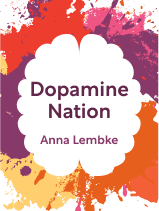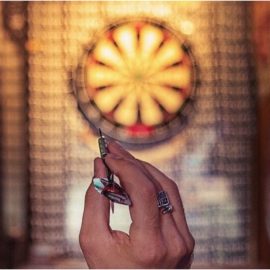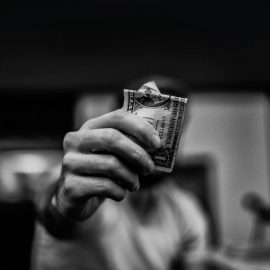

This article is an excerpt from the Shortform book guide to "Dopamine Nation" by Anna Lembke. Shortform has the world's best summaries and analyses of books you should be reading.
Like this article? Sign up for a free trial here.
Want to know how to increase your willpower? What causes a lack of willpower? What strategies do experts recommend?
According to author and addiction expert Anna Lembke’s book, Dopamine Nation, you’re wired to seek out pleasurable activities. The dopamine produced by pleasurable activities can lead to a vicious cycle of overindulgence and a chronic lack of willpower, according to Lembke.
Keep reading to learn how to increase your willpower, according to Lembke’s five strategies.
Why You Lack Willpower
Contrary to popular misconception, the dopamine your brain produces isn’t the “happy chemical” that releases when you receive something pleasurable—it’s the chemical that motivates you to seek out pleasure. Studies have shown this chemical is largely responsible for overindulgence and a lack of willpower because it drives you to continually seek out pleasurable activities, making it hard to know how to stop or how to increase your willpower.
Author and addiction treatment expert Anna Lembke points out that “high-dopamine activities” are not the same for everyone—the high-dopamine activity that motivates you to indulge compulsively may be something “milder” like sugar, video games, or social media.
Some of the highest dopamine-driven activities include gambling, shopping, sex, and using cocaine or methamphetamines. Fortunately, there are practical steps you can take to increase your willpower, and with it, your chances of successfully resetting your homeostatic balance through abstinence.
(Shortform note: In The Willpower Instinct, Kelly McGonigal writes that your bodily health—specifically your heart rate variability, or how much time passes between each of your heartbeats—plays an important role in improving willpower. Generally, she explains, those with a high heart rate variability have a greater sense of willpower. Two ways that you can increase your heart rate variability—and thus your willpower—over time are exercise and relaxing activities like meditating or sitting in a sauna. Consider incorporating exercise and relaxation habits into your abstinence strategy to improve your willpower and chances of following through.)
Since abstaining from pleasure requires a lot of willpower, Lembke recommends strategies for how to improve your willpower.
How to Increase Your Willpower: The 5 Strategies
Before reading over the below strategies, it’s important to note Lembke’s claim that even if there is distance between you and your high-dopamine activity, you still need to make the choice to respect that distance. You need discipline to adhere to strict time limits, as you may be tempted to do an activity “just a little longer.” Finally, even if you avoid most reminders of your temptation, you won’t be able to eliminate all reminders.
Now, let’s explore Lembke’s five strategies for how to improve your willpower.
#1: Spatial Restrictions
Make it physically harder to engage in your high-dopamine activity. By creating more of a physical distance or barrier between yourself and your object of indulgence, you give yourself more of an opportunity to think twice and interrupt thoughtless or automatic habits of consumption. For example, this could take the form of throwing out your junk food or deleting a social media app.
#2: Temporal Restrictions
To increase your willpower, set time limits on when, how often, and for how long you can indulge. This will increase your awareness of how much you are indulging and prevent you from losing track of time and consumption. For example, you could set a timer while playing a video game or only have a cocktail on Friday nights.
#3: Associational Restrictions
Avoid activities that you associate with indulging. Sometimes an activity will remind you of your high-dopamine activity and trigger a craving. By avoiding activities that trigger cravings, you will decrease your frequency of cravings, increasing your willpower and odds of success. For example, someone who compulsively gambles may feel a craving triggered by playing any card game, even ones without betting.
#4: Abstain From Pleasure
To increase your willpower, Lembke recommends that you abstain from your high-dopamine activities for two to four weeks. Remember that repeated indulgence in pleasurable activities induces the brain to balance your seesaw by adding “pain weight.” By abstaining from pleasurable activities—therefore not adding “pleasure weight”—you let your brain recalibrate and take the pain weight off.
However, as Lembke notes, this solution is far from perfect. Abstaining from pleasure requires a lot of self-discipline. The early stages are often accompanied by painful feelings of withdrawal—you’ll have to voluntarily endure this pain without giving into the temptation of relieving it. Once you get through the withdrawal period, you’ll no longer feel the need to indulge.
(Shortform note: Another reason abstaining from pleasure is challenging is because it forces you to work against your habits. In The Power of Habit, Charles Duhigg provides clarity on what makes habits so hard to break. He writes that your brain uses habits to save energy: Once a repeated action becomes automatic, you no longer have to think about it or make a decision. This frees up energy for other activities. When you try to break habits—good or bad—your brain will resist your attempts because it naturally wants to avoid having to expend more energy on decision-making.)
#5: Use Therapeutic Pain
Lembke also suggests that you intentionally press on the “pain” side of the seesaw to increase your willpower. Because your brain strives for equilibrium, feeling pain will cause your brain to take weight away from the pain side. This will undo the effects of your high tolerance for pleasure, leaving you with a neutrally balanced seesaw and a “normal” default state, instead of a painful default state that compels you to seek pleasure for equilibrium. Lembke recommends finding a safe way to experience physical pain, like regularly taking ice water baths or cold showers.
However, she warns, pressing on the pain lever can itself become an addiction. If you experience pain too much or too often, your brain will homeostatically balance its seesaw in the other direction—adding weight to the pleasure side and making you feel good in response to pain. (This is the reason many endurance athletes feel a high after completing a triathlon.) Be careful not to simply substitute one pattern of indulgence for another.
The Difference Between Chronic and Acute Pain
At first, it may seem counterintuitive that pain can help you to increase your willpower or well-being. However, pain researchers shed further light on the benefits of pain by dividing it into two categories: acute and chronic. You experience acute pain in direct response to your environment—for example, the pain you feel if you put your hand in cold water. Your receptivity to acute pain is essential to your health, as it compels you to avoid damage to your body. Conversely, chronic pain is something you experience over long spans of time in response to something internal, such as a back injury. Chronic pain does not provide a clear health benefit and often interferes with your life.
Using this distinction, we see that Lembke’s strategy is to treat chronic pain with acute pain: The “pain weight” on your seesaw is internal and long-term (chronic), whereas the ice water bath is external and short-term (acute). Each experience of acute pain causes your brain to rebalance itself through homeostasis. This takes weight off the pain side so that a chronic experience of “pain weight” is no longer your default.
| The Difference Between Therapeutic Pain and Self Harm Lembke writes that self-administered pain can reset your seesaw and change your habits of overindulgence. However, there’s a sharp distinction to be drawn between experiencing pain in ways that are safe and ways that are harmful. Though often hidden and stigmatized, between 13 and 23% of teenagers have practiced some form of self-harm such as cutting, burning, or puncturing their skin. This is often done to alleviate emotional pain or express self-hatred. Self-harm can also be addictive as it can create pleasurable feelings. While some people find that self-harm creates some of the same neurological responses as therapeutic pain, there is a huge difference in the risk.Taking an ice-cold shower isn’t going to put you in the hospital. On the other hand, self-harm-related injuries are one of the most common reasons teenagers go to the emergency room. |

———End of Preview———
Like what you just read? Read the rest of the world's best book summary and analysis of Anna Lembke's "Dopamine Nation" at Shortform.
Here's what you'll find in our full Dopamine Nation summary:
- What causes addictive behaviors and how to take back control
- How pleasure and pain motivate you to consume
- Strategies for keeping your brain’s natural chemicals in balance






